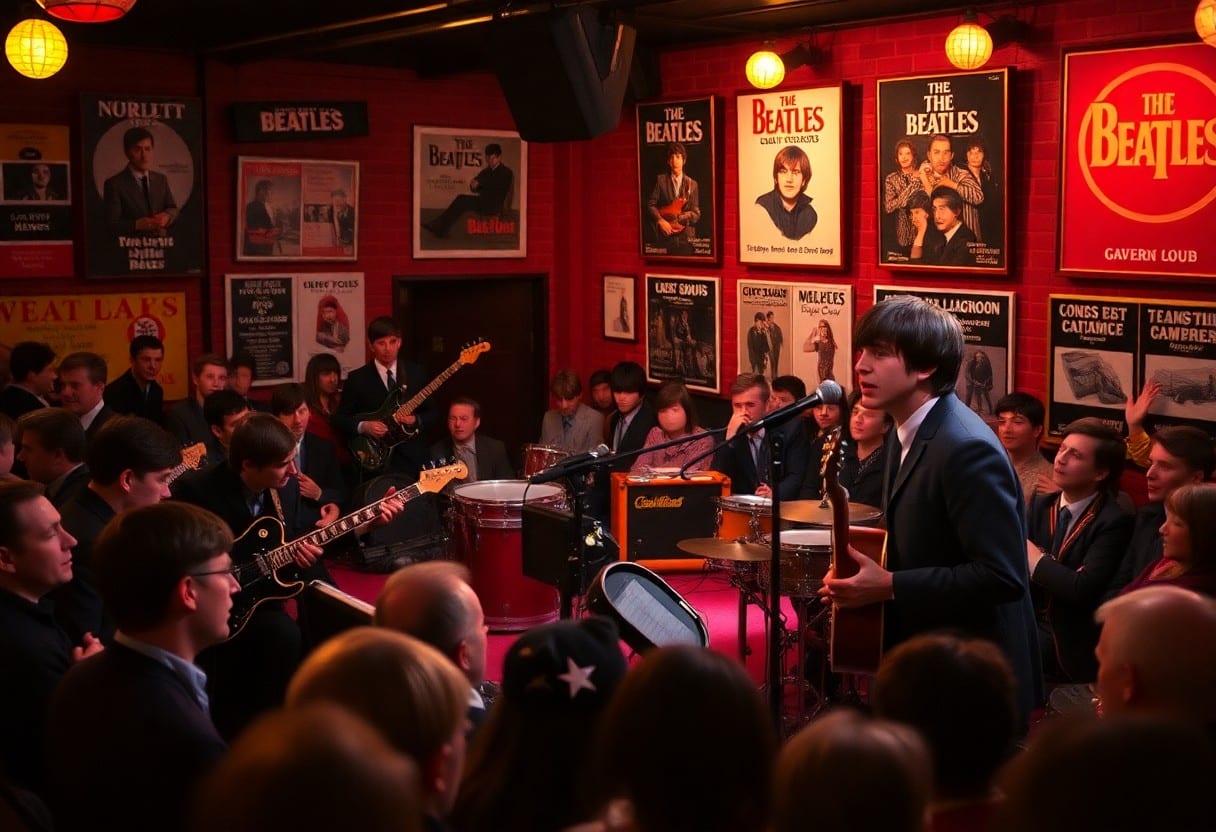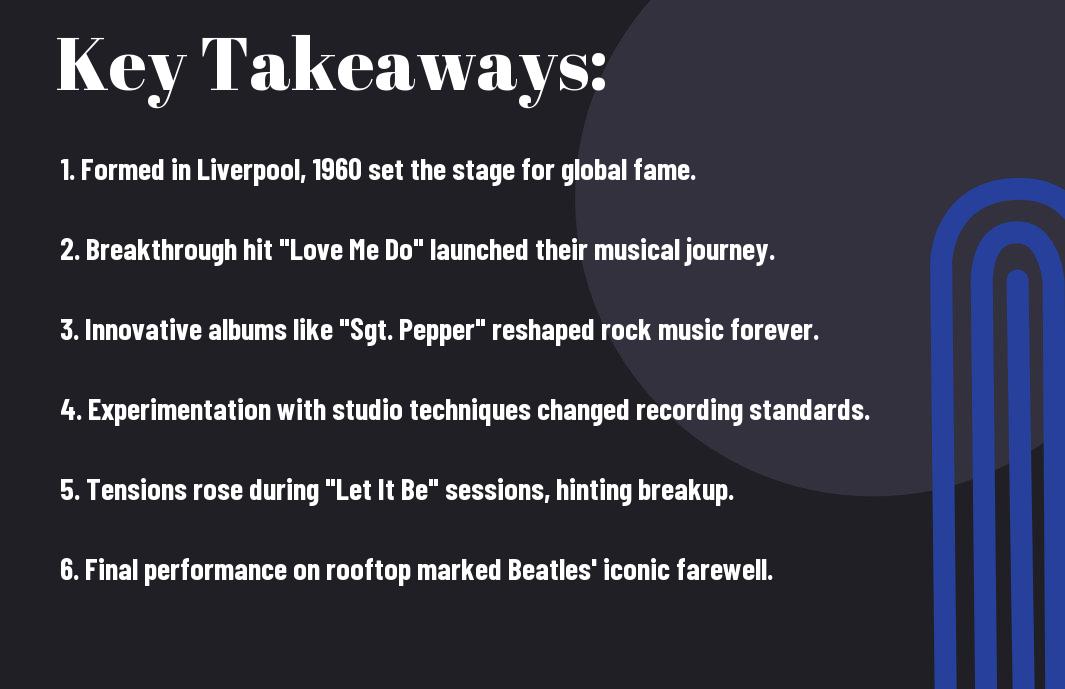There’s a unique magic in exploring the journey of The Beatles, a band that not only changed the face of music but also shaped culture around the globe. In this post, I will take you through ten memorable milestones that defined their path, from their humble beginnings in Liverpool to their final, poignant moments in the studio. You’ll discover how their innovative musical styles and powerful lyrics resonated with millions, leaving a legacy that continues to influence artists today. Join me as we travel through their incredible history.
The Early Years: Liverpool and The Quarrymen
While the story of The Beatles is often painted in vibrant colors of fame and fortune, it all began in the rainy streets of Liverpool. The journey started with a band known as The Quarrymen, formed by a group of local teenagers who shared a passion for music. These formative years laid the groundwork for the magic that would eventually captivate the world, as the band honed their craft and developed a unique sound that would change the face of popular music forever.
Formation of The Quarrymen
For most rock bands, the initial formation is a tale of discovery and friendship, and The Quarrymen were no different. Founded in 1956 by John Lennon, Paul McCartney would soon join as a guitarist, bringing with him a fresh energy. Their shared love for skiffle music invigorated the group, attracting other local musicians, including George Harrison, who would later become a critical member of the band. This early camaraderie became a cornerstone of what would later define The Beatles, as they sought to make a mark in the world of music.
Transition to The Beatles
Any discussion of The Quarrymen’s evolution into The Beatles highlights a pivotal point in music history. Driven by a desire for growth and a deeper exploration of sound, the band underwent a significant transformation. Under John Lennon’s leadership, they rebranded to The Beatles in 1960, which marked the beginning of an incredible journey that would propel them to global stardom.
Even as they transitioned from The Quarrymen to The Beatles, the band faced challenges and exciting opportunities that forged their identity. The original lineup saw changes, with the introduction of drummer Pete Best and later, Ringo Starr, bringing new dynamics to their sound. Their fresh blend of rock and pop, alongside clever harmonies and lyrics, quickly gained traction. This period was not just about their evolution as musicians, but also about navigating the shifting landscape of popular music, ultimately leading to their rise as one of the most influential bands in history.
The Rise to Fame: Beatlemania Takes Over
Now, as the Beatles gained popularity, a whirlwind of excitement enveloped their fans, manifesting in the phenomenon we now call Beatlemania. The group’s infectious melodies and charming personalities captivated audiences around the globe, igniting a passion that would change the music industry forever.
First Hits and Initial Success
One of the band’s earliest chart-toppers, “Please Please Me,” propelled them into the spotlight and set the stage for unprecedented success. Their unique sound and innovative approach to songwriting resonated with millions, making them overnight sensations in the UK.
The Ed Sullivan Show and American Invasion
After conquering the British charts, the Beatles set their sights on America, and their performance on The Ed Sullivan Show marked a turning point in their career. This iconic appearance drew an audience of over 73 million viewers, establishing them as international superstars.
American television audiences were electrified by the Beatles’ charisma and talent during their stunning debut on The Ed Sullivan Show. This performance was a breakthrough moment in music history, sparking a wave of pop culture excitement known as the British Invasion. The Beatles’ infectious energy ignited fervent fan reactions, leading to a historic shift in the music scene. Their arrival not only solidified their status but also shaped a new era of youth culture in the United States, forever changing the landscape of popular music.
Innovative Sound: The Studio Era
Unlike their earlier days, The Beatles’ innovative sound truly blossomed during their studio era. As they moved away from live performances, the studio became their playground for experimentation. This phase allowed them to explore new musical techniques, utilizing advanced recording equipment and techniques that changed the landscape of music forever. For a deep look into the Beatles history – 1968 year, you’ll see how they continued to push the boundaries of creativity.
Rubber Soul and the Shift in Music
Around the time of “Rubber Soul,” I noticed a significant shift in music. The album marked a turning point where The Beatles began to explore into more complex themes and diverse musical styles. They experimented with folk-rock elements, leading to a new sound that not only transformed their music but also influenced countless artists and genres to follow.
Sgt. Pepper’s Lonely Hearts Club Band: Pioneering Concept Albums
Albums like “Sgt. Pepper’s Lonely Hearts Club Band” redefined what music albums could be. At this point, The Beatles took an unprecedented leap into concept albums, uniting their songs under a singular theme and narrative. This creative approach not only showcased their artistic growth but also ignited a revolution in the music industry. The album featured groundbreaking techniques such as vibrant orchestration, experimental sounds, and a cohesive storytelling experience. Its impact was profound, inspiring musicians worldwide to think beyond traditional formats and explore the artistic possibilities within their work.
The Challenges: Internal Struggles and Changes
After achieving unprecedented success, the Beatles faced significant challenges that tested their unity. As their musical journey progressed, personal and professional conflicts emerged, leading to tensions within the band. The stress of fame, creative differences, and evolving personal lives contributed to an increasingly complicated dynamic that ultimately influenced their collaborative efforts and individual paths.
Band Dynamics and Disagreements
Before their rise to stardom, the Beatles shared a strong bond rooted in friendship and shared passion for music. However, as they gained fame, differing artistic visions, and personal ambitions began to clash. Disagreements over songwriting credits, creative control, and the direction of their music strained relationships, making collaboration increasingly difficult.
The Influence of Drugs and Lifestyle
Band members increasingly turned to substances, embracing the counterculture of the 1960s. Internal pressures from fame also drove their experimentation with drugs, which had profound effects on their creativity and interpersonal relationships. While some of this exploration led to innovative musical breakthroughs, the toll became evident as addiction took hold, creating rifts within the group and affecting their health and wellbeing. The dual nature of this lifestyle was both a source of inspiration and a cause of self-destruction, highlighting the fragile balance in their extraordinary journey.
The Later Years: Experimentation and Evolution
Despite their immense popularity, The Beatles refused to be confined by traditional pop music norms during their later years. Instead, they ventured into uncharted territories, embracing *new genres and unconventional recording techniques*. This period of experimentation not only showcased their *musical evolution* but also reflected their personal growth as artists. With each album, they challenged the status quo, ultimately reshaping the landscape of modern music.
The White Album and Diverse Styles
About “The White Album,” it’s often revered for its eclectic mix of styles, capturing everything from *folk to avant-garde*. This double album serves as a testament to each member’s individuality, allowing them to express their unique musical visions while still collaborating harmoniously. The diversity in sound and themes showcases The Beatles’ unparalleled creativity during this transformative period.
Abbey Road: A Fitting Conclusion
An iconic masterpiece, “Abbey Road” stands as a fitting conclusion to The Beatles’ illustrious career. Released in 1969, it features some of their most significant and beloved songs, uniting their individual evolutions into a cohesive work. The album’s *sophisticated production techniques* and *timeless melodies* illustrate their mastery of the craft, showcasing an iconic harmony in their personalities and artistry.
Understanding “Abbey Road” requires acknowledging the *tension* that surrounded the band as they navigated personal and professional changes. This album, characterized by its *rich harmonics and innovative composition*, offers insight into their *collective genius* and artistry before their eventual split. The seamless transitions between songs, particularly in the famed medley on Side B, highlight their *collaborative spirit* even in the midst of *growing discord*. This poignant blend of unresolved tension and artistic brilliance makes “Abbey Road” a final celebration of their *unmatched legacy*, ensuring it will forever resonate with audiences around the world.












